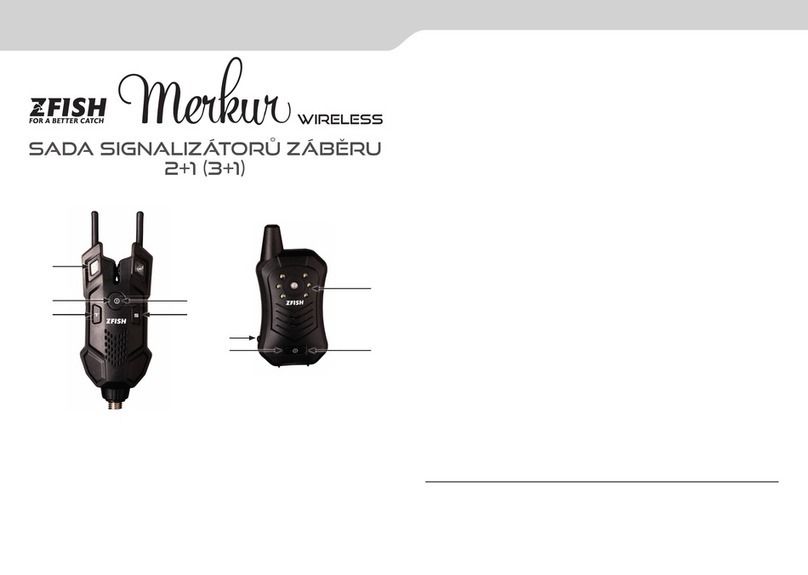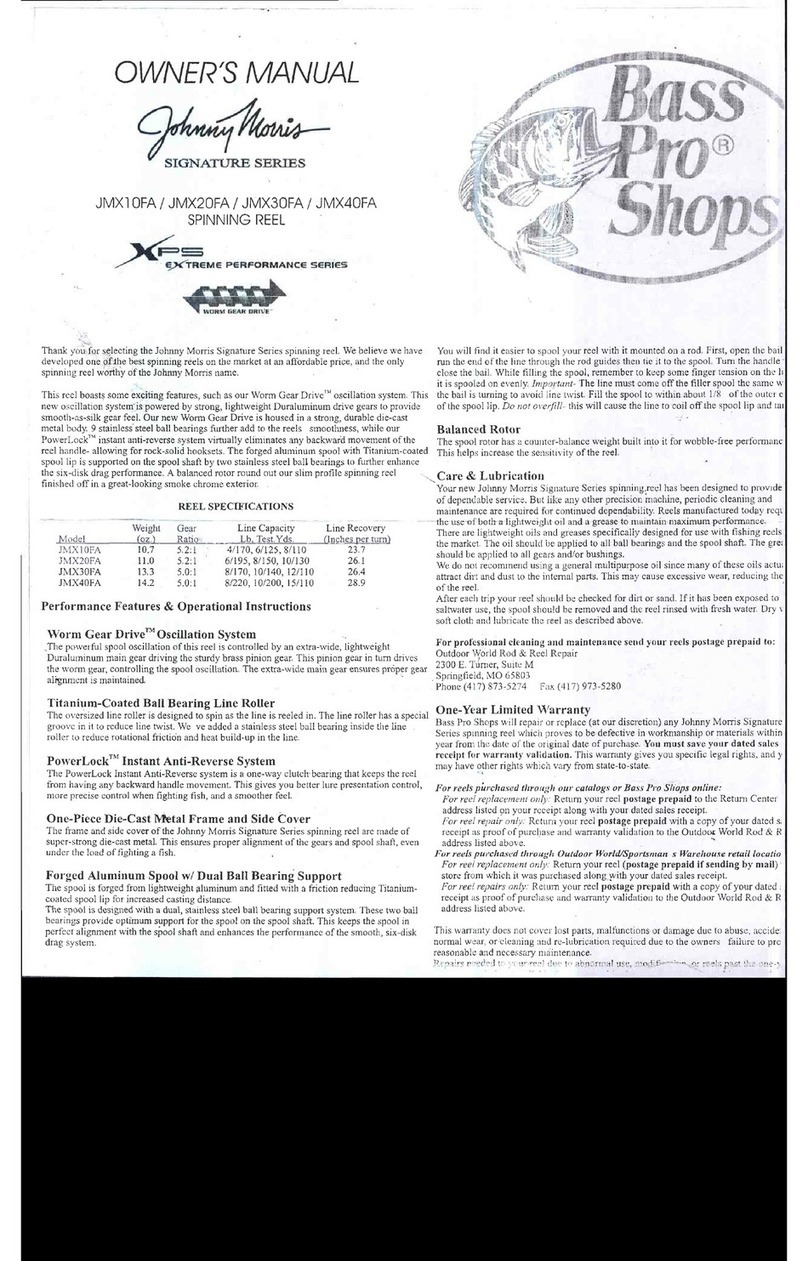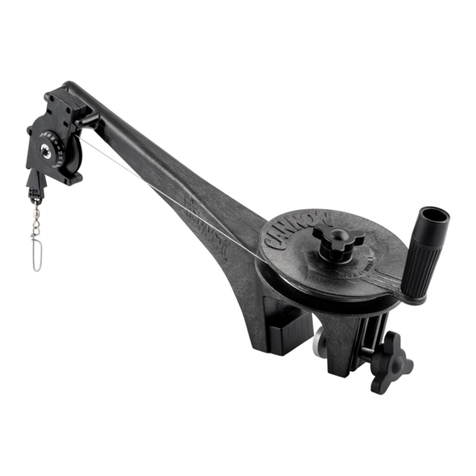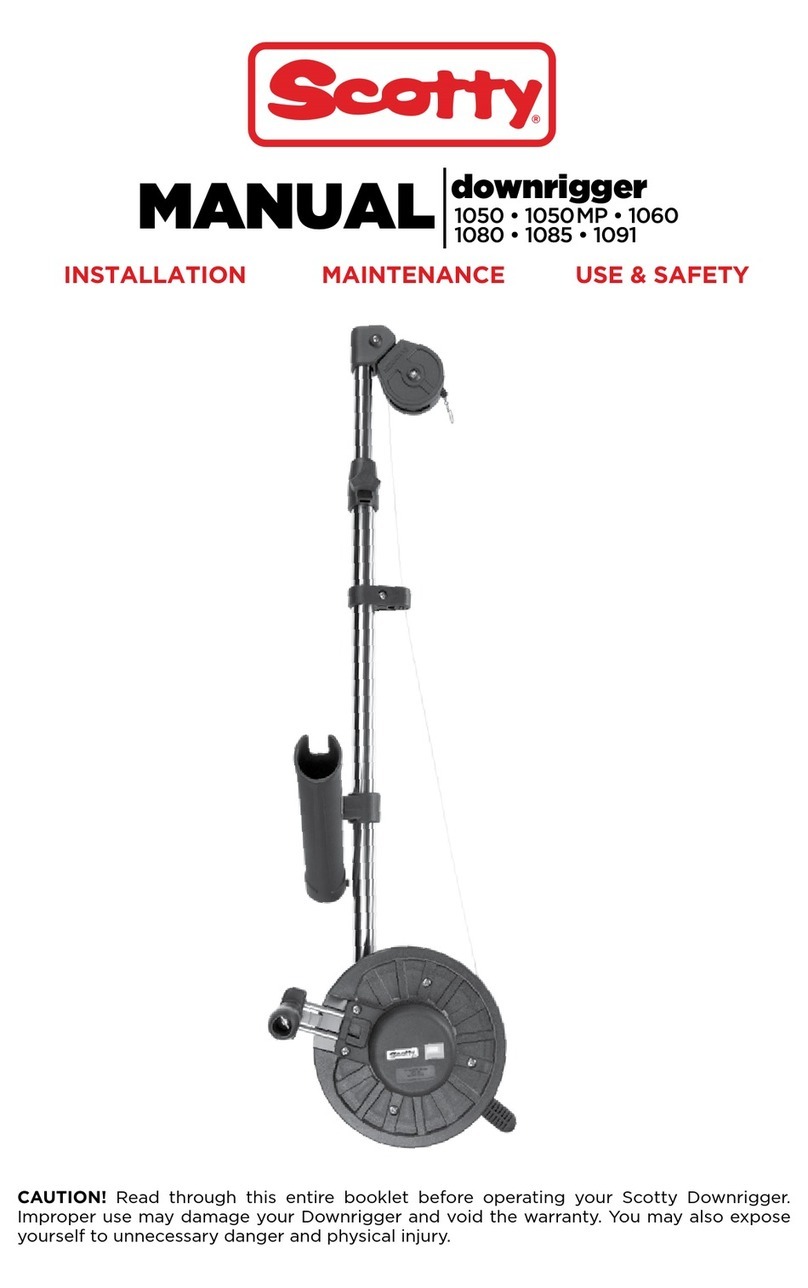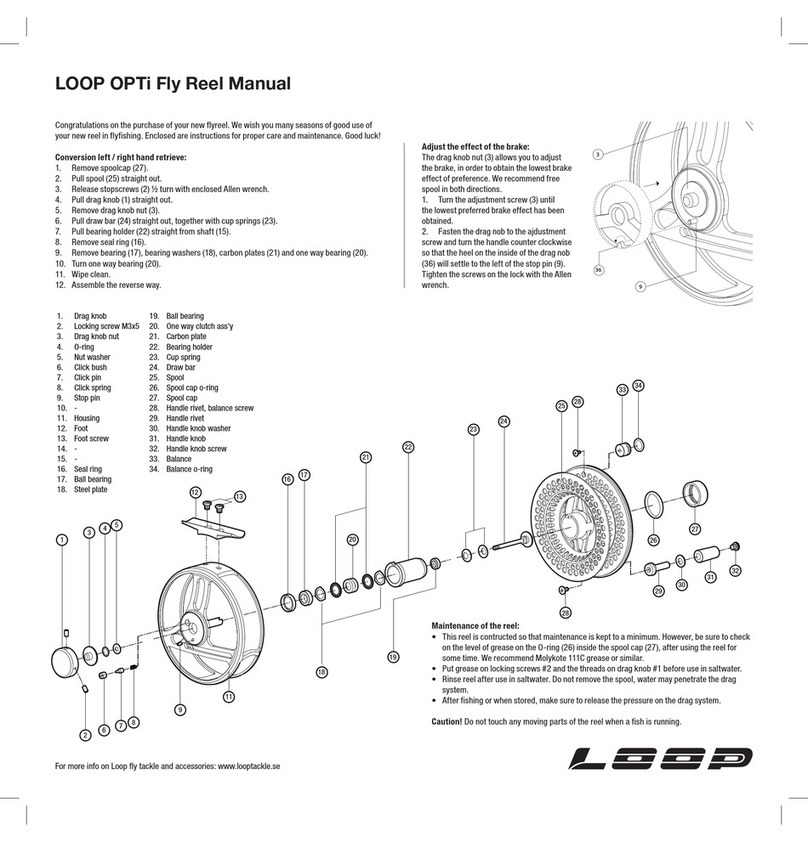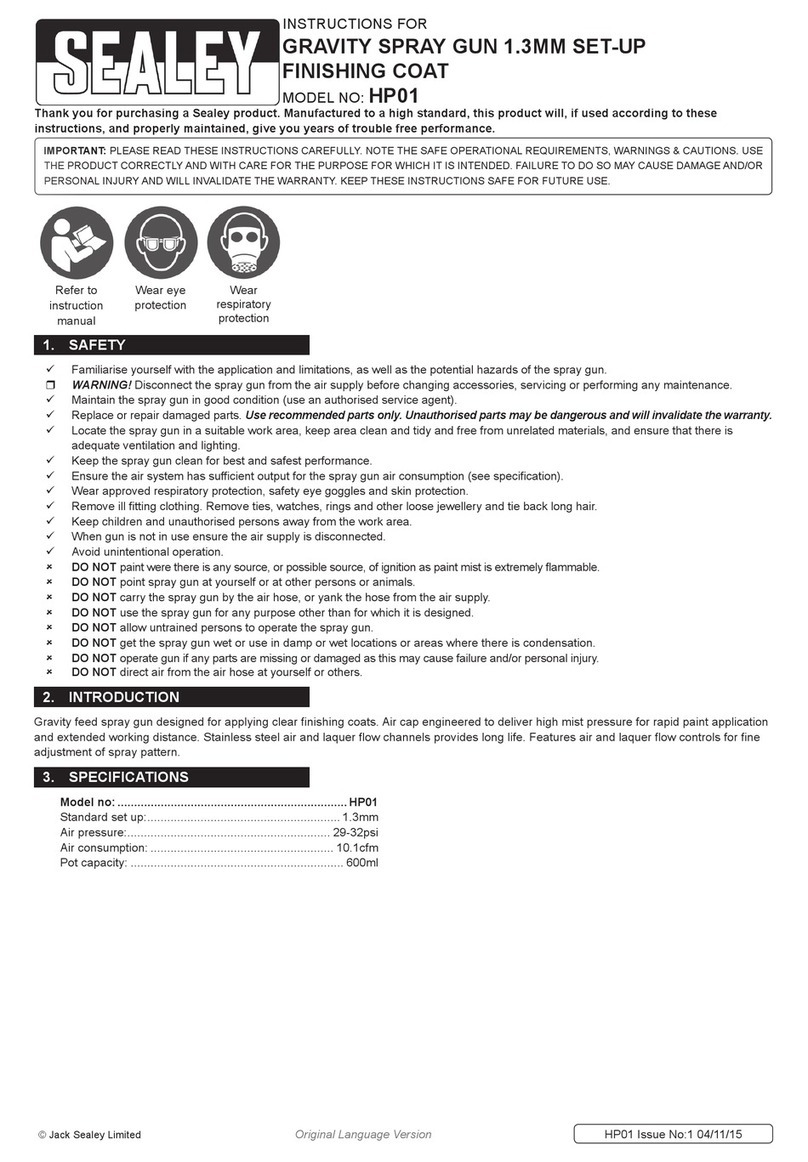Fish Hawk X4D User manual

Thank you for your purchase. For over 30 years anglers have relied on Fish Hawk
Electronics to give them accurate speed and water temperature information to help
them catch more fish. As a family owned and operated small business, we enjoy
working personally with each of our customers.
If you like our products and customer service, please tell your fishing friends
about us and take a moment to write a review or visit us at facebook.com/Fish-
HawkElectronics.
If you have any questions about your Fish Hawk, please contact us. Thank you
again, and have a safe and enjoyable fishing season
Sincerely,
Trevor Sumption
President, Grayden Outdoor, LLC.

2015
Fish Hawk X4D
Owner's Manual

www.fishhaw electronics.com 3 www.fishhaw electronics.com 3
Table of Contents
The Search for the Right Water Temperature .............................................4
Fish Hawk Components ......................................................................5
Fish Hawk System .......................................................................... 5
Fish Hawk Upgrade Kit ..................................................................5
Fish Hawk Probe ............................................................................5
How the Fish Hawk Operates ...............................................................5
The Fish Hawk Probe .......................................................................... 6
Installing the Batteries .....................................................................6
Turning the Probe On and Off ..........................................................6
Low Battery Warning ......................................................................6
Attaching the Probe to the Downrigger Cable ...........................................6
Attaching the Downrigger Ball ..........................................................7
Selecting the Proper Weight Downrigger Ball ........................................7
Installing the Transducer .....................................................................7
Selecting a Location for the Transducer ................................................7
More Transducer Mounting Tips: .......................................................8
Sonar Interference ..........................................................................9
The Fish Hawk LCD Display ................................................................9
Installing the Display ......................................................................9
Adjusting the Angle of the Display .....................................................9
Using the Fish Hawk Display ...............................................................9
Setting the Gain – Screen #1 .......................................................... 10
Setting the Temperature Unit of Measure – Screen #2 ........................... 11
Setting the Speed Unit of Measure – Screen #3 ..................................... 11
Calibrating the Sensors – Screen #4 ................................................... 11
Using the Fish Hawk Mobile App ........................................................ 11
Routine Maintenance ........................................................................12
Trouble Shooting .............................................................................12
Warranty .......................................................................................13
Service ..........................................................................................13
Warranty Repairs .........................................................................13
Out of Warranty Repairs ...............................................................13
Flat Rate Repair Charge Chart .............................................................14
Service Tips ................................................................................14

4 Fish Hawk Owners Manual
The Search for the Right Water Temperature
Every body of water has temperature changes from the top to the bottom. There
are layers of water where the temperature will be significantly different. These are
differences are referred to as “temperature breaks” or the “thermocline.” Often
fish will travel along the thermocline or temperature break, and finding these ar-
eas is key to finding fish
Each species of fish lives in a preferred water temperature range. The chart be-
low shows the preferred water temperature range for the most popular freshwater
game fish and baitfish species in Fa enheit.
Preferred Water Temperature Ranges
(shown in Fahrenheit)
Species Lower Limit Optimum Upper Limit
Brown Trout 44 52 75
Chinook Salmon 40 44 60
Coho Salmon 44 54 60
Crappie 60 70 75
Kokanee 52
Lake Trout 40 42 55
Largemouth Bass 50 70 80
Atlantic Salmon 45 50 60
Rainbow Trout 44 54 63
Smallmouth Bass 50 65 73
Steelhead 42 45 62
Walleye 50 67 76
Alewife 48 54 72
Cisco 53
Emerald Shiner 61
Gizzard Shad 69
Rainbow Smelt 43 50 57
Spottail Shiner 54
Fish suspend in the water column by water temperature. Using your Fish Hawk will
allow you to find them. With the Fish Hawk you can create a temperature profile of
the water column by lowering the probe close to the bottom and observing the water
temperature as you slowly raise the probe to the surface. This will allow you to find the
correct water temperature for the species you are targeting.

www.fishhaw electronics.com 5
The Search for the Right Water Temperature
Every body of water has temperature changes from the top to the bottom. There
are layers of water where the temperature will be significantly different. These are
differences are referred to as “temperature breaks” or the “thermocline.” Often
fish will travel along the thermocline or temperature break, and finding these ar-
eas is key to finding fish
Each species of fish lives in a preferred water temperature range. The chart be-
low shows the preferred water temperature range for the most popular freshwater
game fish and baitfish species in Fa enheit.
Preferred Water Temperature Ranges
(shown in Fahrenheit)
Species Lower Limit Optimum Upper Limit
Brown Trout 44 52 75
Chinook Salmon 40 44 60
Coho Salmon 44 54 60
Crappie 60 70 75
Kokanee 52
Lake Trout 40 42 55
Largemouth Bass 50 70 80
Atlantic Salmon 45 50 60
Rainbow Trout 44 54 63
Smallmouth Bass 50 65 73
Steelhead 42 45 62
Walleye 50 67 76
Alewife 48 54 72
Cisco 53
Emerald Shiner 61
Gizzard Shad 69
Rainbow Smelt 43 50 57
Spottail Shiner 54
Fish suspend in the water column by water temperature. Using your Fish Hawk will
allow you to find them. With the Fish Hawk you can create a temperature profile of
the water column by lowering the probe close to the bottom and observing the water
temperature as you slowly raise the probe to the surface. This will allow you to find the
correct water temperature for the species you are targeting.
Fish Hawk X4/X4D Components
The Fish Hawk can be purchased as a complete system or as an Upgrade Kit for
previous models. Replacement Probes are available separately if needed. Depending
on which configuration you have purchased, your package will include the following:
Fish Hawk System
• Transducer with 30’ cable
• Transducer mounting kit
• LCD display
• Power cord for LCD display
• LCD display stand
• Fish Hawk Probe
• Breakaway cannonball wire safety lead
• Protective rubber probe bumper
• This Owner’s Manual
Fish Hawk Upgrade Kit
• LCD display
• LCD display stand
• Fish Hawk Probe
• Breakaway cannonball wire safety lead
• Protective rubber probe bumper
• This Owner’s Manual
Fish Hawk Probe
• Fish Hawk Probe
• Breakaway cannonball wire safety lead
• Protective rubber probe bumper
• This Owner’s Manual
How the Fish Hawk Operates
The Fish Hawk Probe is fastened to the downrigger
cable just above the downrigger ball and has sensors that
constantly monitor water temperature and speed as it
travels through the water. The probe sends a sonar signal
with that information to the Transducer mounted on the
back of the boat. The Transducer, which is hooked up to
the LCD display, sends the data from the Probe and the
water’s surface to the liquid crystal display (LCD) mount-
ed in the boat.
As the water temperature, speed or depth (model X4D
only) changes, the LCD updates to reflect the new infor-
mation. To compensate for wave action, speed is calculated
over a 20-second period. The probe operates at depths
from 1 to 300 feet.
X4 Digital Display
Transducer
Transmitter
Downrigger
Ball
Downrigger
Line
Temperature
Sensors
Speed
Sensor
Break-Away
Lead
Probe

6 Fish Hawk Owners Manual
The Fish Hawk Probe
Installing the Batteries
The Probe is powered by four AA Alkaline batteries (not included.) Do not use
Heavy Duty or rechargeable batteries. Fresh Alkaline bat-
teries will provide 100+ hours of in-the-water life
depending on water temperature. To install
the batteries:
Unscrew the probe’s battery cap. Care-
fully pull the battery holder out of the probe.
Place the four batteries into the battery holder
matching the appropriate +/- terminals. Please note:
pay special attention to the polarity of the batteries because the probe will function if only
three of four batteries are correctly installed, but the readings provided may be inaccurate.
Place the battery holder back into the probe with the battery wires facing the
rear of the probe. The wires are designed to be longer to make replacing batteries
easier. Please note: if the battery holder is replaced with the wires facing the front of the
probe the slack wire can get caught in the threads of the cap, damaging the battery wires.
While this easily repaired it may cause you to lose fishing time with the p obe.
Turn the battery cap back onto the probe and hand-tighten snug. Do not over-
tighten. The battery cap has a double O-ring design that does not need to be overly
tight to keep water out of the battery compartment. Keep the O-rings clean and
lightly lubricated.
Turning the Probe On and Off
The Fish Hawk Probe features a water sensitive auto on/off switch that turns the
probe on when it is lowered into the water and shuts the probe off when it is removed
from the water, conserving battery life. To test the probe, simply wet your fingers and
place them across the two activated metal temperature sensors coming out of the front
of the probe. A red LED inside the body
of the probe will flash when the probe
is on.
Low Battery Warning
When the probe’s bat-
teries are low a LOW BAT sign will ap-
pear in the center of the LCD display. When the LOW
BAT sign is present and the probe readings appear as dashes it is time to change
the batteries in the probe.
Attaching the Probe to the Downrigger Cable
Terminate your downrigger cable following your downrigger manufacturer’s in-
structions. Prior to attaching the probe it is a good idea to inspect the downrigger
cable for and kinks or frays that might weaken the downrigger cable which could
cause you to lose your valuable Fish Hawk Probe. Attach using a high quality snap
run through the stamped stainless steel loop on top of the Fish Hawk Probe.
Twist off Battery Cap
Pull out battery holder
Flashing Red LED
Water sensitive
Auto On/Off switch

www.fishhaw electronics.com 7
Attaching the Downrigger Ball
Included in the box is a break-away wire lead
that goes between the Probe and the downrigger
ball. Attach one end of this lead to the stamped
stainless steel loop on the bottom of the Fish Hawk
Probe and the other end to the downrigger ball.
The break-away lead is approximately 60lb test
and is designed to break in the event you snag
your downrigger weight on the bottom.
Probe “Bumper”
A clear silicone rubber bumper
comes installed on the Fish Hawk
Probe. The bumper provides addi-
tional protection for the thermistor
tubes against accidental damage. For
storage, remove the Probe Bumper,
insuring that trapped moisture does
not turn the probe on when not in
use.
Selecting the Proper Weight Downrigger Ball
Although it is minimized, water resistance from the Probe will cause some ad-
ditional drag on the downrigger line. If you consider the sway in the downrigger
line to be too much, a heavier downrigger ball can be used (i.e. switching from a
10 pound ball to a 12 pound ball.)
Installing the Transducer
Properly installing the Transducer on the back of your boat is key to getting
the best performance from your new Fish Hawk.
Properly located, the Transducer will be com-
pletely immersed in the water at trolling speeds
and will ride nearly flush with the bottom of the
hull at planning speeds.
Selecting a Location for the Transducer
The Transducer should be located in an area
not affected by turbulence from the hull or motor.
To locate the best place on the transom to mount the Transduc-
er, observe the water flow out from under the hull at trolling
speeds and while on plane. At trolling speeds look for the area
Connect probe to
downrigger line here.
Connect probe to
Break-away Lead here.
Break-away Lead
Downrigger Ball
Note
The X4/X4D probe is very durable, but denting
the temperature sensor probes will cause your probe to read 03.9 or 04.0. Remove the
probe from the downrigger cable and store in a protected place when not in use.

8 Fish Hawk Owners Manual
that has the least amount of prop or back wash. At planning speed look for the area
with the least amount of turbulence or bubbles. This will be the best place to mount
the Transducer.
Mount the Fish Hawk Transducer as far away as possible from other transducers
that operate within 20 kHz of the 70 kHz Fish Hawk Transducer. When possible,
mount your Fish Hawk Transducer on the opposite side of the boat from other trans-
ducers. The Transducer has a wide angle of 77-degrees that permits the signal to be
received near the surface while increasing reception the deeper the probe goes.
More Transducer Mounting Tips:
• Most often the Fish Hawk Transducer should be mounted using the same
criteria as most fish finders
• DO NOT cut the Transducer cable. If the cable is too long simply coil the
excess out of the way. Ten foot cable extensions are available for sale on-line from
Fish Hawk Electronics if a longer cable is needed.
• When possible run the Transducer cable through its own hole through the
transom above the waterline.
• Watch the Transducer installation video found on the Fish Hawk Website by
clicking on “Videos” in the “About” dropdown menu.
• We install marine grade plastic transducer mounting boards on the back of
our boats because they allow us to change the position of transducers without
drilling new holes in the transom.

www.fishhaw electronics.com 9
Sonar Interference
Sonar interference is caused when similar sonar frequencies are used in close
proximity to one another. The Fish Hawk uses a 70 kHz frequency while most fis
finders operate around 200 KHz, meaning the Fish Hawk will not interfere with
most fish finders. Some dual frequency finders use a 50 or 83 kHz frequency that can
interfere with the Fish Hawk at high gain settings if the transducers are mounted too
close together on the transom. You can opt not to use the 50 or 83 kHz frequency in
your fish finde ’s settings if it causes a problem, or relocate the Transducer on the
transom. Fish finders that have a user adjustable pulse width setting can be set to
less than 800 microseconds if they cause interference. Lowering the gain will help
the Fish Hawk minimize interference but may reduce the usable depth range.
The Fish Hawk LCD Display
Installing the Display
Place the display in a visible location on the helm. An optional
foul weather cover is available for purchase on-line if
you plan on leaving the display in an exposed location.
You can flush mount the display into your
boat’s console by cutting a 3 1 ⁄2” wide x 6 1 ⁄8”
tall hole in the dash and using a silicone sealant
to secure the display in place.
The display requires that two connections be
made; the power cord and the Transducer. Addi-
tional wire can added to the power cable if you
follow the proper polarity (+/-.) The display is
protected by an in-line 1 amp fuse. As with most
radio or sonar devices, we recommend wiring
the display directly to a 12-volt battery. Con-
necting to a fuse block can result in unwanted
electrical noise that can interfere with the Fish
Hawk.
Adjusting the Angle of the Display
You can remove, or adjust the angle of the LCD display by pressing the tabs at
the top of the mounting base.
Using the Fish Hawk Display
The Fish Hawk Display is divided into a top and bottom section. The top half
of the display shows water temperature and boat speed at the surface, and the bot-
tom half of the display shows water temperature and speed at the probe. Actual
Probe depth is displayed as the top number on the model X4D. If the probe signal
is not detected, dashes will appear for both the probe temperature and speed. To
indicate that the probe is functioning correctly, every time a new signal is received
the decimal points in the probe readings will flash
Pull rubber fuse
housing apart to access fuse.
Use the four
holes at the
bottom of
the base to
secure it in
place. There
are two holes on
each side of base.

10 Fish Hawk Owners Manual
The POWER button turns the display on and off. The display draws 35 mA when
on and .3 mA when off. The display is equipped with a backlight for low-light con-
ditions. Enable the backlight by pressing the UP arrow or turn the backlight off by
pressing the DOWN arrow. The model X4D has three levels of backlighting.
The display has four screen settings. To access each setting press the SET but-
ton, each time the SET button is pressed, the display will move to the next setting.
• Screen #1 allows you to set the gain (sensitivity) with a range of 0-25, the de-
fault is 15. Use the UP and DOWN arrows to adjust.
• Screen #2 allows you to set the temperature unit of measure to Fahrenheit or Cel-
sius, the default is Fahrenheit. Use the UP and DOWN arrows to adjust.
• Screen #3 allows you to set the speed unit of measure to MPH, KNOTS, or
KPH, the default is MPH. Use the UP and DOWN arrows to adjust.
• Screen #4 allows you to calibrate the sensor readings, + or – 5 degrees F on the
temperature, and up to two-times adjustment for the speed. Use the
UP and DOWN arrows to adjust. You can exit these screens by press-
ing the POWER button at any time. All changes are saved at that point.
POWER
Button
SET
Button
UP
Arrow
DOWN
Arrow
Probe
Speed
Probe
Temperature
Current
Settings
Surface*
Speed
Surface
Temperature
POWER
Button
SET
Button
UP
Arrow
DOWN
Arrow
Probe
Speed
Probe
Temperature
Current
Settings
Probe*
Depth
Surface
Temperature
Setting the Gain–Screen #1
The gain is also referred to as sensitivity, and ranges
from 0 to 25. The factory default setting of 15 usually
provides excellent results. The gain control only has
an effect on the probe function. Most of the time no
or only small adjustments are necessary. Increasing
the gain allows probe readings to be received from
greater depths. Lower gain settings reduce the pos-
sibility of other sonar or electrical interference, and
also may be necessary in shallow water
Current gain setting
being displayed.
Press UP
arrow to
increase
gain
setting.
Press
DOWN
arrow to
decrease
gain
setting.

www.fishhaw electronics.com 11
Using the Fish Hawk Mobile App
The Fish Hawk model X4D features built in Bluetooth® Smart wireless technol-
ogy that sends display data to mobile devices. Download the free Fish Hawk Elec-
tronics Mobile App from the App Store (for Apple® devices with iOS 8 or newer)
or Google Play (for Android® devices.)
Once downloaded, the Fish Hawk Electronics App will allow you to use your
mobile device as an auxiliary display anywhere in the boat.
The App’s Catch Log feature allows you to save the details of every catch, in-
Calibrating the Sensors–Screen #4
While not necessary, you have the ability
to calibrate speed if desired. Remember that
due to differences in transducer mounting,
no two boats will read speed exactly the
same. Calibration is best done when water
conditions are calm. Lower the Probe 5-feet
under the transducer and compare the sur-
face speed to the Probe speed. Press the SET
button until the speed reading flashes for the sensor
you want to adjust. Once that speed reading flashes,
press the UP or DOWN arrow to adjust. Once you’ve ad-
justed the speed readings to match each other, press the
POWER button once to save your changes.
Factory setting values are denoted for each sensor by a missing decimal point.
If you wish to go back to the factory settings press the UP or DOWN arrow until
the reading flashes without a decimal point. The factory default value is always in
the middle of the adjustment range. When the reading flashes without a decimal
point, press the POWER button once and the factory default will be restored.
The reading will
flash when selected.
Press the SET
button to select
the next item to
calibrate.
Calibration
Indicator.
Press UP or DOWN arrows
to define the setting that is
flashing.
Setting the Speed Unit of Measure–Screen #3
This screen allows you to select the unit of measure for speed.
The surface and probe speeds will automatically be in the same
unit of measure. The Fish Hawk will display speeds from .4 MPH
to 11 MPH at the probe and from .4MPH to planning speeds at
the surface.
Current speed
configuration.
Press UP or DOWN arrows to toggle be-
tween the MPH – KNOTS – KPH settings.
Current temperature
configuration.
Setting the Temperature Unit of Measure–Screen #2
This screen allows you to select which temperature unit of mea-
sure is displayed on the screen. The Fish Hawk will display tem-
peratures ranging from 32 degrees to 104 degrees Fahrenheit.
Press UP or DOWN arrow to
toggle between °F and °C.

12 Fish Hawk Owners Manual
cluding: the species and size of fish caught, Probe depth, Probe temperature, Probe
speed, time, GPS coordinates (optional,) and notes (lure info, weather conditions,
etc…) The Catch Log is organized by date, and you easily share logged catch infor-
mation with fishing buddies in other boats via text message or email
Routine Maintenance
Your Fish Hawk requires simple maintenance to keep it working properly. Use
the following schedule to keep your Fish Hawk in top working order:
Item Check Action Interval
Liquid Crystal
Display Check for dirt and wa-
ter spots on the screen. Clean with soft cloth. Daily
Transducer Check for marine
growth or deposits on
the face.
Clean with a soft bristle brush. Weekly
Downrigger
Cable Check for kinks for
fraying. Replace cable. Daily
Probe Batteries Check for power. Replace if LED is not flashing
inside the probe or if LO BAT
appears on the display.
Daily
Probe O-Rings Check for dirt and
lubrication. Clean and apply a light coating
of silicone lubricant if dry. Do
not over-lubricate.
Weekly
Break-away Cable Check for kinks or
fraying. Order replacement cable if bad. Daily
Probe Check for condensation
in battery cap Loosen battery cap at the end of
each day Daily
Trouble Shooting
Please refer to the following table to help you identify and correct some of the more
common troubleshooting scenarios we encounter.
Problem Possible Cause Solution
Display won’t
turn on The 1-amp in-line fuse is
broken Replace the 1-amp fuse found near the end
of the power cord
No probe data
appears on the
display
The probe is out of the water
The batteries in the probe
are dead
The transducer is not placed
correctly on the transom
The Gain adjustment is set
too low
The probe is too close to the
boat
The probe is only on when in the water
Replace with fresh alkaline AA batteries
Locate the transducer in a spot on the tran-
som where bubbles are minimized. Do not
locate the transducer near a kicker motor.
Make sure the transducer face is level with
the water’s
Press the SET button on the display. The
default setting is 15, use the arrow up key
to increase the gain. The Gain may need to
be set higher in water deeper than 150’ or
with cannon balls
The probe needs to be at least 5-feet under
the transducer

www.fishhaw electronics.com 13
Warranty
The Fish Hawk has one-year warranty from the date of purchase that covers all
defects in materials and workmanship for the original owner. Grayden Outdoor
LLC will at its sole discretion repair or replace components that fail during normal
use. Failures due to abuse, neglect, or loss are not covered under this warranty.
Service
“HELP, I can’t fish without my Fish Hawk!” Many customers tell us that their
Fish Hawk is so important to their fish catching success that they won’t fish with-
out it. Fishing season is too short and we want you to maximize every trip out –
which means keeping your Fish Hawk in the water. That’s why we make getting
service easy, to get you back on the water as quickly possible. If you have a ques-
tion we’ll return your call or e-mail the same day (Monday through Friday 8a.m.
-4:30p.m. CST.)
Warranty Repairs
If your Fish Hawk product was purchased within one-year, please contact us
and we’ll arrange to repair or replace the product at no cost to you. Please have a
copy of your sales receipt, or credit card statement, or cancelled check available.
Out of Warranty Repairs
If your product is outside of the one-year warranty, you can send it to us right
away without contacting us and we’ll fix it for a flat rate (see chart below.) Please
ship the product back to us along with a note describing the problem, your return
shipping address, phone number, and payment for the repair, plus $10 for return
Problem Possible Cause Solution
The probe
temperature on
the display reads
3.8 - 4.0
The thermistor tubes on the
probe have been damaged To prevent this from ever happening,
remove the probe from the downrigger
cable when not in use, or secure the probe
tightly to the downrigger with a bungee.
Unfortunately there is no way to repair the
damage, the probe must be replaced.
Probe numbers
on the display are
erratic
Sonar interference from a
50 or 83 KHz transducer lo-
cated next to the Fish Hawk
transducer (70 KHz) on the
transom.
The fastest way to eliminate this is to turn
off the 50 KHz or 83 KHz beam on your
fish finder ad You can also try reducing
the Gain setting on the Fish Hawk display
by pressing the SET button and then the
arrow down key, or separating transducer
cables if tied together. The permanent
solution is relocating the transducer away
from other 50 or 83 KHz transducers on
the transom.
Surface and
probe numbers
on the display are
erratic
Electrical interference from
the boat Run the Fish Hawk display power cord di-
rectly to the boat battery and not through
a fuse panel
The Fish Hawk
display turns on
or off when you
start the engine.
There is an open ground in
the power system Replace the standard spark plugs with
resistor value spark plugs

14 Fish Hawk Owners Manual
shipping. We recommend sticking your address label on each part you ship back
to us. Payment may be made by check or credit card. If you choose to include your
credit card information, please provide the expiration date and security code.
Flat Rate Charge Repair Time*
Model Flat Rate Charge Repair Time*
X4D Probe $200 up to 3 working days
X4D LCD $240 up to 3 working days
X4 Probe $165 up to 3 working days
X4 LCD $200 up to 3 working days
*Repair time does not include inbound or outbound transit times
SERVICE TIPS
Here are some other tips that make the repair process more hassle free:
• Ship your product back via Fed Ex, UPS, or Priority Mail so you get a tracking
number.
• Very seldom is the Transducer the problem – contact us prior to removing the
Transducer from the boat.
• Visit our website, www.fishhawkelect onics.com to view trouble shooting
videos and FAQ, it may save you time and money.
• Attach an address label to each piece you send to us
Contact Information:
Grayden Outdoor, LLC.
Phone (218) 454-4760
Fax (218) 824-1422
www.fishhawkelect onics.com
Return Shipping Address:
Grayden Outdoor, LLC.
Attn: Fish Hawk Service
211 NW 4th St.
Brainerd, MN 56401


Other manuals for X4D
1
Table of contents
Other Fish Hawk Fishing Equipment manuals
Popular Fishing Equipment manuals by other brands
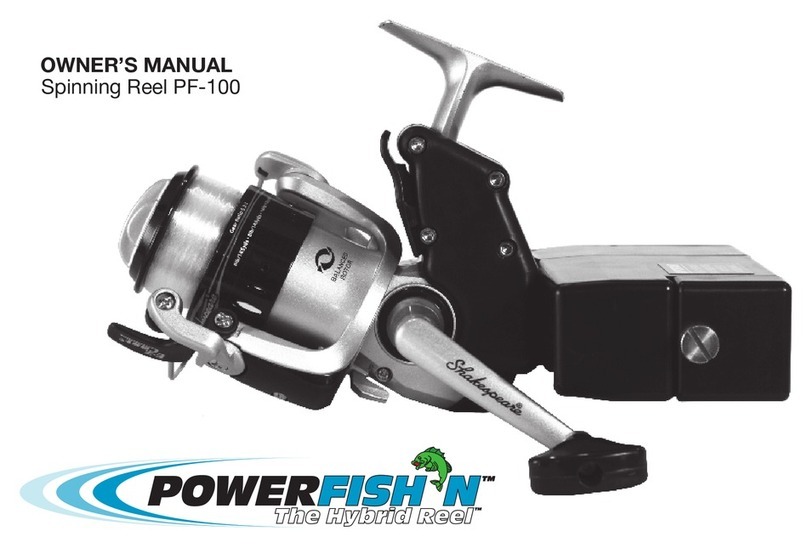
Rock Island Equipment
Rock Island Equipment PowerFish'n Pro PF-100 owner's manual
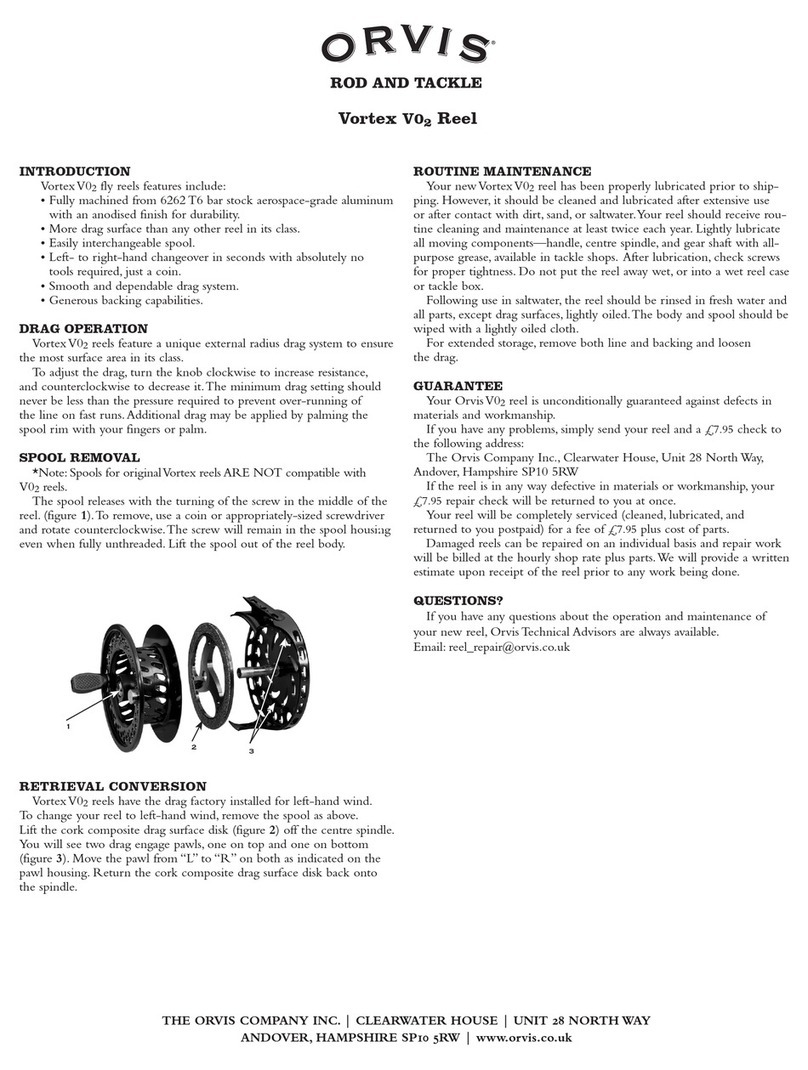
ORVIS
ORVIS Vortex V02 Reel quick start guide

Brinkmann
Brinkmann 800-1512-0 Owner's manual & operating instructions

SensorTronics
SensorTronics STRIKE SENSOR instructions
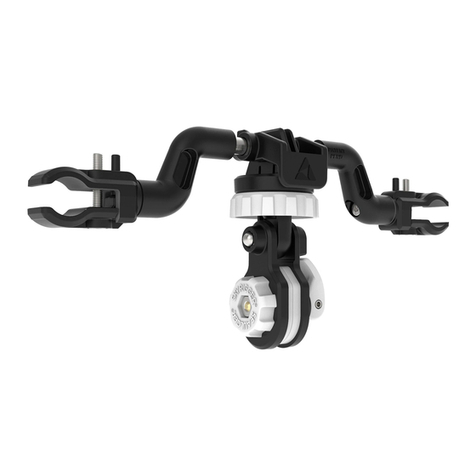
Sea Ulcer
Sea Ulcer SKY RIGGER user manual
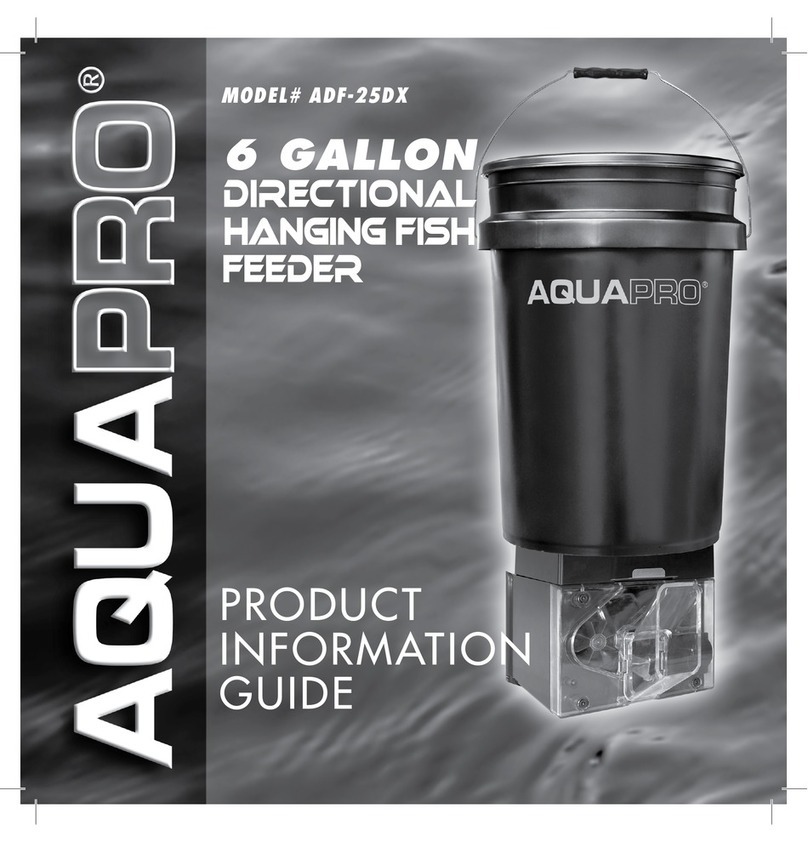
Aquapro Fish Feeders
Aquapro Fish Feeders ADF-25DX Product information guide


